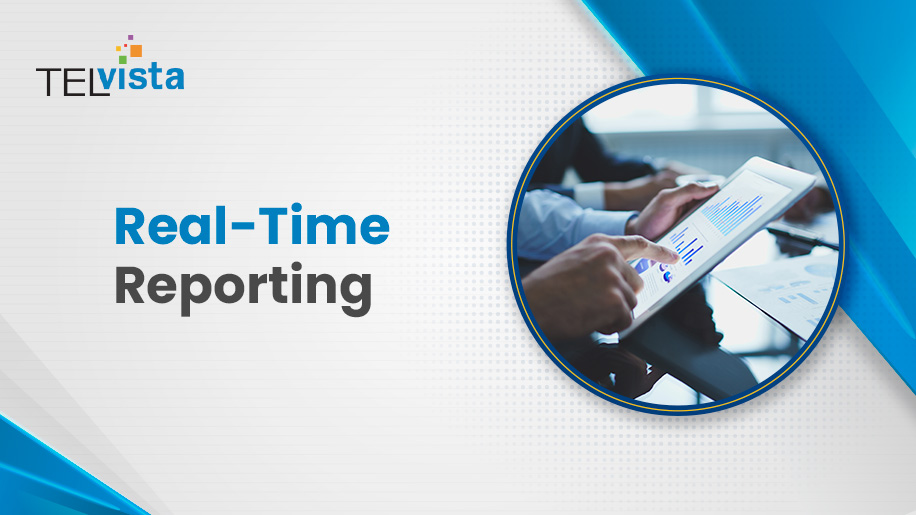In a time when customer service has a major impact on a business’s overall performance, real-time reporting can significantly boost the quality of customer interactions. Customer service standards of today demand monitoring, reporting, and analytics to take place as they happen. Data stored in silos for later viewing is an outdated strategy and cannot improve the processes compared to a real-time approach.
Reporting in real-time allows agents, quality, and management staff to assess every interaction as it happens. The data visualized in dashboards benefits contact center solution providers in various ways increasing transparency and response time, identifying areas of improvement, and quickly acting on trending data.
How Does Real-Time Reporting Work?
Data is collected from software applications and tools like interactive voice response (IVR), workforce management solutions (WFM), automated call distributor (ACD), and customer relationship management (CRM). This data is then organized and visualized into simplified reports and dashboards.
Visualized reports allow seeing the performance of customer interactions at the same time as they are happening. These dashboards also show historical data, and the target goals, so viewers can quickly see how well the performance complies with the trends and goals. Irregularities in patterns can trigger notifications or change color so management can see when an agent needs assistance in assisting customers.
Reporting in real-time helps track the following metrics:
First Contact Resolution
The number of customer queries resolved in the first interaction divided by total queries is the first contact resolution rate. It is a crucial contact center metric as the need for more interactions leading to a solution negatively affects the customer experience. A high FCR rate is so important that outsourcing solutions providers highlight their resolution rate as one of the key benefits of hiring them. Real-time reporting can identify any callers who have previously called in within a set period of time.
Average Wait Time
An average wait time is the time customers wait in the queue before an agent attends to their query. Long wait times cause frustrations on the customer side and degrade the experience. Based on the reports, managers can hire agents to handle a shift and train agents to increase the efficiency of operations.
Average Call Handle Time
The time it takes from the time an agent answers the call to the time the call is completed. This may or may not include some after-call work time if follow-up time is needed. AHT is linked to the effectiveness of the call-handling process and an agent’s productivity. Insights from the real-time tracking dashboard can motivate agents to improve performance and lower the average handle time.
Quality of Interaction
The quality of interaction has a direct impact on the customer experience. Different aspects like empathy, tone, and professionalism in interaction help measure the quality. Contact centers use AI-powered tools for this purpose. The visualized reports of interactions across live chat, call, and email in an omnichannel contact center shows them important insights.
Individual Agent and Team Performance Tracking
When the metrics on historical data are viewed together, they present a clear image of the performance of your team and individual agents. These insights help develop coaching and training programs while providing agents with immediate feedback on how they are doing to the skills they are working to improve.
Benefits of Reporting in Real-Time
Leveraging monitoring in real-time helps contact centers optimize their operations in a variety of ways. The following are key benefits of adopting this reporting model and technology:
Transparency
The transparency of performance benefits both contact centers and customer service agents. Contact centers can quickly identify trends and adjust staff and assignments to get performance back on track. Any internal biases by the managers towards agents may be removed with autogenerated reports leading to the creation of a healthy working environment.
Agents can get feedback throughout the day, self-assess, and work on their weaknesses to offer better quality service. The visualized data can make agents more self-accountable and proactive in learning and improving.
Companies can see the effects of a new working strategy from their dashboards. For example, the insights from the visualized reports after leveraging workforce management solutions can show an improvement in productivity when compared to past data.
Improve Customer Experience
When agents are able to view how they are doing during an ongoing interaction, it naturally improves the service. Agents can mold their responses to a customer’s query and see how it shows up in the reports. Also, self-accountability and meeting the company standards push them to achieve more first contact resolutions and faster AHT.
Agent teams being able to see visualized performances may create a healthy competition that engages employees and improves performance. The management can take the required steps in overcoming factors in the way of offering quality customer service.
Dynamic Decision Making
Discussing performance the next day or week delays important decisions, and often prevents goals from being recoverable for the measurement period. In contrast, reporting in real-time allows contact centers to have fast and data-driven decision making. The access to visualized reports helps agents prioritize what’s important. For instance, agents can adjust their tone, call control, hold time, etc. when these metrics are made immediately available to them and have an immediate impact on the quality of service.
Conclusion
Real-time reporting eliminates the delays and areas of errors in traditional reporting. It helps agents achieve their KPIs and improves the overall customer experience with a brand. Further, smart decision-making and boosts in productivity help businesses to adapt to customer needs and continuously optimize processes.




